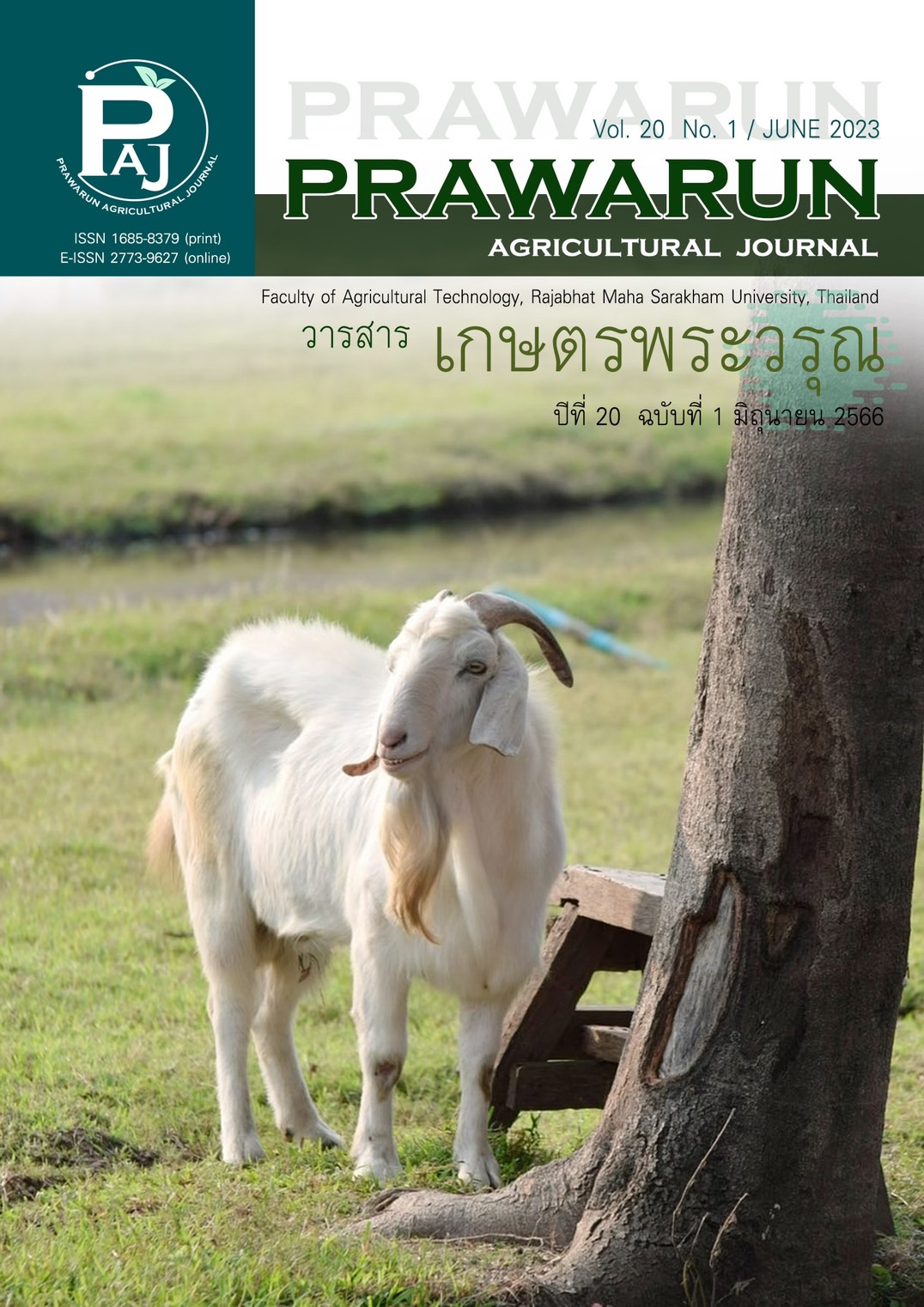การพัฒนาผลิตภัณฑ์ข้าวเกรียบเสริมมันเทศและโปรตีนจากแมลง
Main Article Content
บทคัดย่อ
งานวิจัยนี้มีวัตถุประสงค์เพื่อพัฒนาผลิตภัณฑ์ข้าวเกรียบเสริมมันเทศและโปรตีนจากแมลง โดยทำการศึกษาสัดส่วนของส่วนผสม 3 ชนิด ได้แก่ ปริมาณแป้งมันสำปะหลัง (300-500 กรัม) ผงจิ้งหรีด (200-400 กรัม) และมันเทศ (300-500 กรัม) ต่อลักษณะทางประสาทสัมผัสของผลิตภัณฑ์ข้าวเกรียบ วางแผนการทดลองแบบ mixture design เพื่อศึกษาสัดส่วนของปริมาณแป้งมันสำปะหลัง ผงจิ้งหรีด และมันเทศ ต่อความชอบรวมของผลิตภัณฑ์ข้าวเกรียบ ผลการศึกษาพบว่าปริมาณสัดส่วนที่เหมาะสมต่อการผลิตผลิตภัณฑ์ข้าวเกรียบ คือ การใช้แป้งมันสำปะหลัง ผงจิ้งหรีด และมันเทศ ปริมาณ 428 200 และ 372 กรัม ตามลำดับ ทำให้ได้ค่าความชอบรวมของผลิตภัณฑ์สูงสุดเท่ากับ 7.87 สำหรับผลิตภัณฑ์ข้าวเกรียบเสริมมันเทศและโปรตีนจากแมลงสูตรที่ดีที่สุดมีองค์ประกอบทางเคมีในด้านโปรตีน ใยอาหาร และแร่ธาตุสูงสุดเมื่อเปรียบเทียบกับข้าวเกรียบทางการค้า (ข้าวเกรียบกุ้งและข้าวเกรียบปลา) ส่วนอัตราการขยายตัวของผลิตภัณฑ์ข้าวเกรียบเสริมมันเทศและโปรตีนจากแมลงมีค่าไม่แตกต่างจากข้าวเกรียบกุ้ง แต่มีค่าสูงกว่าข้าวเกรียบปลา (p≤0.05)
Article Details
เอกสารอ้างอิง
Association of Official Analytical Chemists (AOAC). (2002). Official methods of analysis of AOAC International (17th ed.). Gaithersburg, Maryland: AOAC International.
Boonyaputthipong, W. (2001). Study on physicochemical properties of roots, flour and starch of sweet potatoes from Amphoe Nam Yuen, Ubon Ratchatani Province (Research report). Ubon Ratchatani: Ubon Ratchatani University. (in Thai)
Department of Agricultural Extension. (2020). Study on cultivation of five Japanese yam varieties (Research report). Chiangmai: Office of Agricultural Extension and Development. (in Thai)
Fernandez-Cassi, X., Supeanu, A., Vaga, M., Jansson, A., Boqvist, S., & Vagsholm, I. (2019). The house cricket (Acheta domesticus) as a novel food: a risk profile. Journal of Insects as Food and Feed, 5(2), 137-157. doi: org/10.3920/JIFF2018.0021
Jino, T., Surawang, S., & Wachirasiri, K. (2021). Chemical composition and optimum condition of protein concentrate extraction from commercial crickets. Thai Journal of Science and Technology, 10(1), 64-73. doi: org/10.14456/tjst.2021.5
Mekarat, S., Chedoloh, R., Puwaphut, R., & Hilae, A. (2018). The development on formulation of fish cracker supplemented with sacha peanut leaf. Princess of Naradhiwas University Journal, 11(1), 125-134.
Mohamed, S., Abdullah, N., & Muthu, M. K. (1989). Physical properties of keropok (fried crisps) in relation to the amylopectin content of starch flour. ournal of the Science of Food and Agriculture, 49(3), 369-378. doi: org/10.1002/jsfa.2740490312
Nicolas, L., Marquilly, C., & O'Mahony, M. (2010). The 9-point hedonic scale: Are words and numbers compatible?. Food Quality and Preference, 21(8), 1008-1015.
Office of Agricultural Economics. (2022). Situation of important agricultural products and trends in 2023. Bangkok: Bureau of Agricultural Economics Research. (in Thai)
Pathare, P. B., Opara, U. L., & Said, F. A. (2013). Colour measurement and analysis in fresh and processed foods: A review. Food and Bioprocess Technology, 6, 36-60.
Prikboonchan, S. (2002). Quality development of fish cracker (Research report). Phitsanulok: Pibulsongkram Rajabhat University. (in Thai)
Promphakping, B., & Wongon, M. (2020). Agriculture and food: Old problem in the new research and development agendas. Journal of Humanities and Social Sciences, 9(1), 1-18. doi:10.14456/connexion.2020
Sihamala, O., Saraboot, N., Chunthanom, P., & Bhulaidok, S. (2018). Nutritional value of edible insects in Kalasin province. King Mongkut’s Agriculture Journal, 36(2), 98- 105.
Siriamornpun, S., & Thammapat., P (2008). Insects as a delicacy and a nutritious food in Thailand. Accessed February 20, 2023. Retrieved from https://www.academia.edu/7657158/Insects_as_a_Delicacy_and_a_Nutritious_Food_in_Thailand
Suriya, P., Thamaragsa, N., Kaewtein, S., Pocarat, R., & Arkanit, K. (2011). Product development of Burma bean chip. Proceedings of the 2nd MJU-Phrae national research conference (pp. 276-283). Phrae: Maejo University Phrae Campus. (in Thai)
Thammapat, P., Ongnarm, N., Yothawong, A., Raksarad, S., & Palakawong Na Ayudhya, C. (2021). Development of baked crispy snack of eggplant leaves fortified with protein from insects. Prawarun Agricultural Journal, 18(2), 80-86. (in Thai)
Thanakate, S. (2016). Development of seasoned tapioca crackers (Thai snack) fortified with khlu leaf extract (Research report). Bangkok: Rajamangala University of Technology Phra Nakhon. (in Thai)
Yu, S. Y., Mitchell, J. R., & Abdullah, A. (1981). Production and acceptability testing of fish cracker ('keropok') prepared by the extrusion method. Journal of Food Technology, 16(1), 51-58. doi::org/10.1111/j.1365-2621.1981.tb00995.


